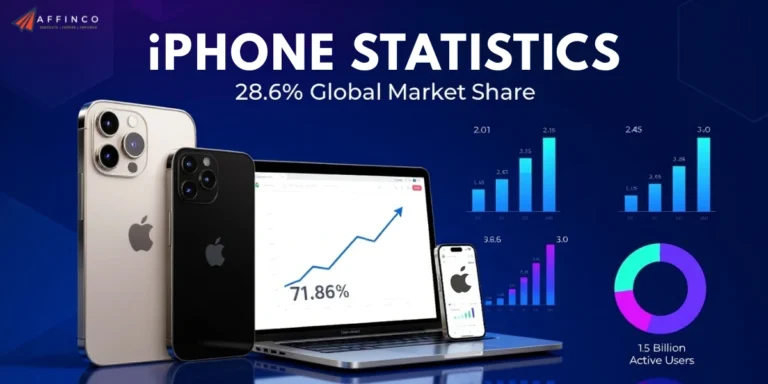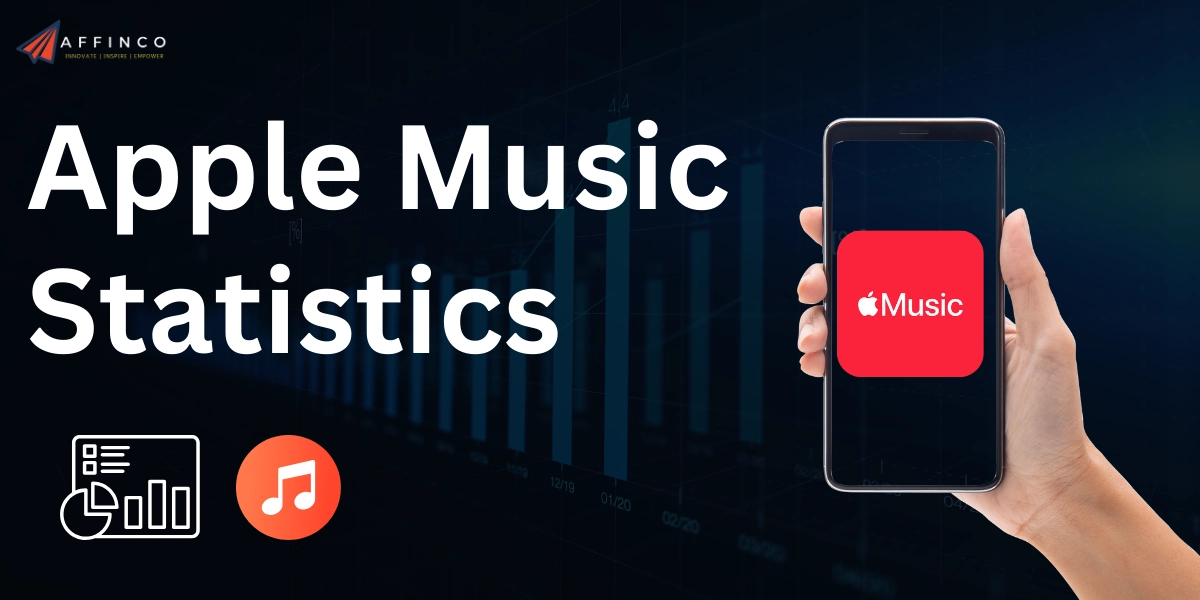
Apple Music continues crushing the streaming game with 108 million paying subscribers and a projected $10.5 billion revenue in 2025. The platform pays artists $0.01 per stream while maintaining a 30.7% market share in the United States.
Your streaming service choice impacts both your listening experience and the artists you support. Apple Music stands out with lossless audio, over 100 million songs, and zero ads across all plans.
We've gathered the latest Apple Music Statistics covering subscriber growth, revenue performance, artist payouts, and market competition to give you the complete picture of Apple's music streaming success story.
Key Apple Music Statistics for 2025
Apple Music's performance in 2025 highlights its strong position in the digital music sector. The platform has achieved notable milestones in subscribers and revenue, making it a primary competitor in the streaming market.
| Metric | 2025 Figure |
|---|---|
| Total Subscribers | 108 million paying subscribers worldwide, highlighting steady growth and premium user bas |
| Projected Revenue (2025) | $10.5 billion estimated revenue, based entirely on subscriptions without ads |
| Song Library Size | Over 100 million songs available across all genres with 30,000 curated playlist |
| US Subscriber Market Share | Holds 30.7% share, second only to Spotify in the U.S. market |
| Average Pay Per Stream | Pays artists $0.01 per stream, among the highest in the streaming industry |
| Global Availability | Available in 167 countries, showing wide international reach |
Such points summarize Apple Music's current market position, financial health, user base composition, and strategic outlook for 2025.
Subscriber Growth and Global Reach
Apple Music's subscriber count reflects its consistent expansion and appeal to a worldwide audience. The service has successfully added millions of users year after year, reinforcing its status as a top-tier streaming option.
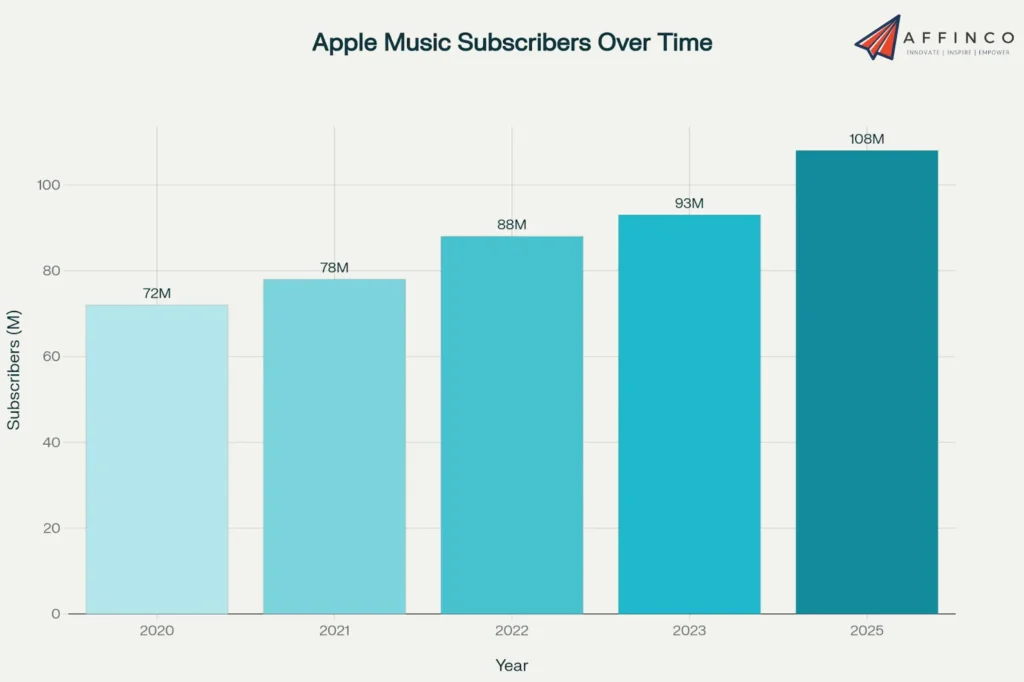
This sustained growth is a key indicator of its long-term viability and ability to compete.
Apple Music's growth demonstrates its effective strategy of bundling with Apple's hardware and focusing on high-quality user experiences. Its expansion shows no signs of slowing as it continues penetrating new markets.
Year-Over-Year Subscriber Increases
Trajectory patterns of Apple Music's subscriber growth show consistent, strong gains. Such upward trends highlight increasing platform popularity and successful user acquisition strategies over recent years.
Analyzing such growth provides insight into market performance and momentum.
| Year | Subscribers (in millions) | Annual Growth |
|---|---|---|
| 2025 | 108 | 16.1% |
| 2023 | 93 | 5.7% |
| 2022 | 88 | 12.8% |
| 2021 | 78 | 8.3% |
| 2020 | 72 | 20.0% |
Such steady increases in subscribers are fundamental to Apple Music's financial success. It also reflects growing consumer shifts toward subscription-based music consumption.
Annual Revenue Performance
Apple Music's revenue figures show a robust and growing income stream for Apple's Services division. The platform consistently generates billions of dollars annually, with forecasts pointing toward continued financial expansion.
This financial strength is a direct result of its subscription-only model and growing user base.

This financial performance is critical to Apple, showcasing the value of its services segment. The consistent revenue growth highlights the platform's ability to monetize its user base effectively.
Revenue Contribution to Apple's Services
Apple Music is a significant component of Apple's rapidly growing Services category. It contributes a meaningful portion of the revenue that helps diversify Apple's income beyond hardware sales like the iPhone.
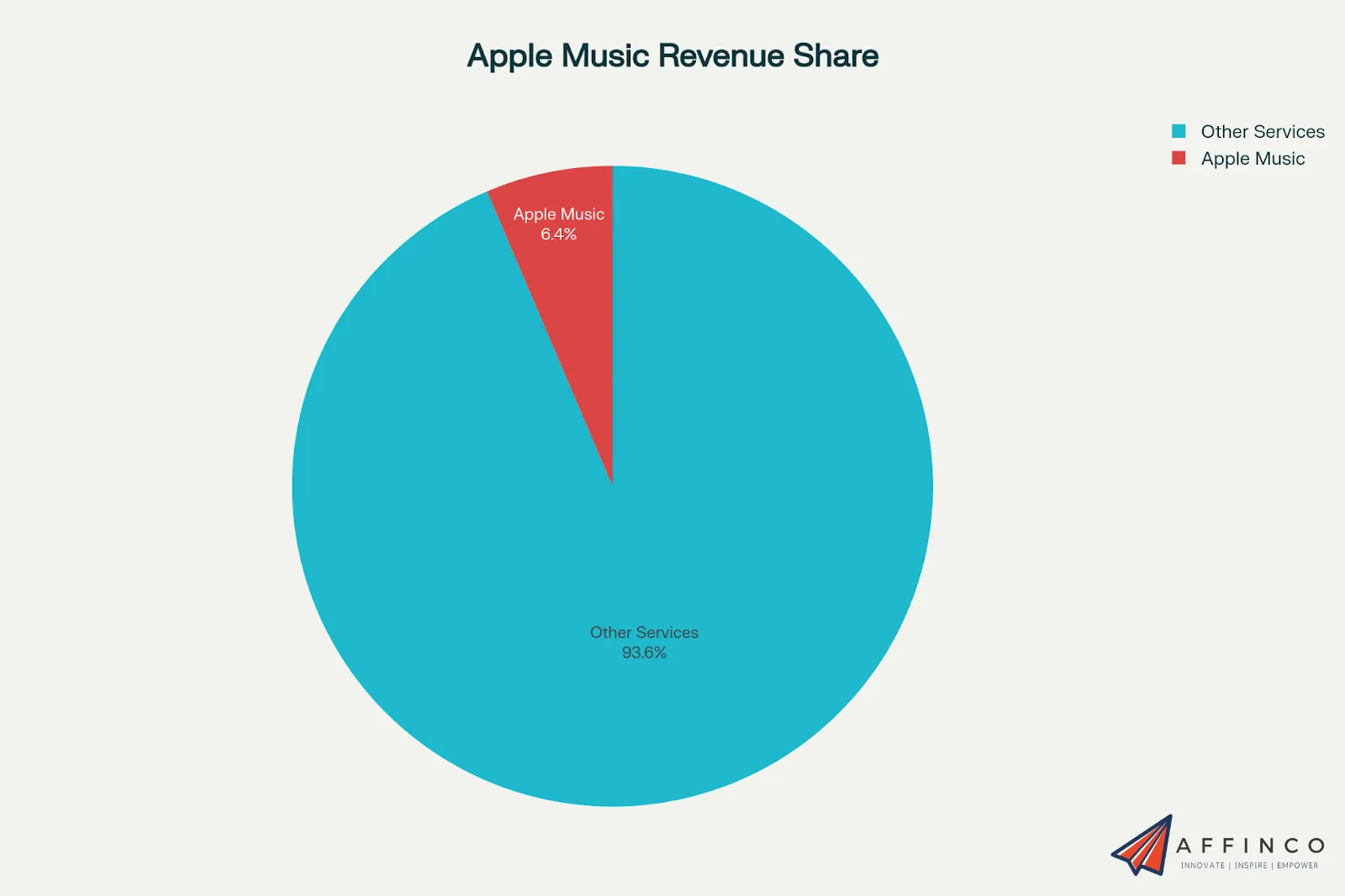
The platform's financial contribution helps solidify the importance of content and subscriptions in Apple's long-term business plan.
The success of Apple Music is integral to the health of the entire Services division. It shows how content platforms can create significant, reliable income streams for a technology giant.
Market Share in the United States

Apple Music has secured a formidable position in the U.S. music streaming market. It is the second-largest service by subscriber share, demonstrating its strong appeal to American consumers.
This standing is particularly notable given the intense competition from other major platforms.
Its significant share in the American market underscores its success in attracting and retaining high-value customers. This strong foothold is a key asset in its global strategy.
Global Market Position
On the world stage, Apple Music holds a significant portion of the music streaming market. While it trails the global leader, Spotify, its share is substantial and represents a large, dedicated user base.
The platform's global presence is a testament to its widespread appeal and the power of the Apple brand.
This approach results in a different but still very successful market position. It prioritizes revenue per user over the sheer volume of total users.
User Demographics by Gender
The gender distribution of Apple Music's user base shows a slight preference among female listeners. Understanding this demographic is important for content curation, marketing, and artist promotions on the platform.
These user statistics help shape the listening experience for millions of people.
Knowing the gender split allows for more targeted content and promotional efforts. It is a key piece of information for understanding the platform's audience.
Age Distribution of Subscribers
Apple Music appeals to a wide range of age groups, with a notable concentration among adults in their prime spending years. This broad appeal is a sign of a mature and widely accepted service.
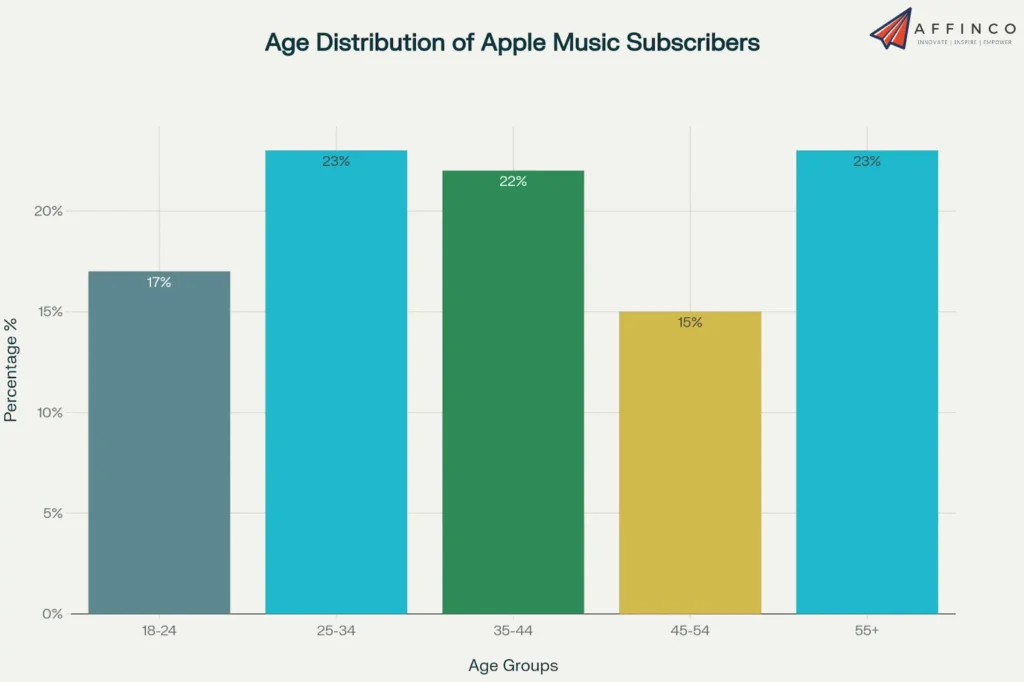
The age demographics indicate the platform's ability to cater to diverse musical tastes and generational preferences.
This distribution shows that Apple Music is not limited to a single generation. Its features, like high-quality audio, likely contribute to its popularity among older, more discerning listeners.
Artist Payout Rates
Apple Music's artist-friendly payment model attracts content creators and influences industry standards. Higher per-stream rates benefit artists compared to ad-supported platforms.

Artist Payment Details:
- $0.01 per stream average payment
- $1 billion+ annual artist payouts
- 100% subscription revenue sharing model
- No ad revenue dilution affecting payouts
| Platform | Pay Per Stream | Payment Model | Artist Benefits |
|---|---|---|---|
| Apple Music | $0.01 | Subscription | Highest Rate |
| Spotify | $0.003-$0.005 | Mixed Revenue | Variable |
| YouTube Music | $0.002 | Ad-Supported | Lower Rate |
| Amazon Music | $0.004 | Tiered | Moderate |
Higher payment rates strengthen artist relationships and exclusive content opportunities. This strategy differentiates Apple Music in competitive content acquisition.
Most-Streamed Artists and Tracks
The platform's streaming charts are often dominated by global superstars who attract millions of listeners. Taylor Swift has been a particularly dominant force on Apple Music, setting numerous records for streams and chart performance.
Her success on the platform highlights its role in modern music consumption.
- Taylor Swift is the most-streamed artist on Apple Music, with over 70.2 million total streams since 2013.
- Swift has had 65 songs reach the Global Daily Top 100 chart, more than any other artist.
- Other top-performing artists include Ed Sheeran, Drake, and Billie Eilish, each with tens of millions of streams.
These artists' popularity drives significant engagement on the platform. Their new releases often lead to spikes in user activity and attract new subscribers.
Content Library and Audio Features
Apple Music boasts an extensive music catalog that is competitive with any other service on the market. In addition to its size, the platform distinguishes itself with superior audio quality options that appeal to discerning listeners.
These technical advantages provide a clear differentiator from many competitors. They cater to a segment of the market that prioritizes sound fidelity over other features.
Apple Music vs. Spotify: A Competitive Overview
The rivalry between Apple Music and Spotify defines the modern music streaming market. While Spotify leads in total user numbers, Apple Music has built a highly profitable and loyal subscriber base.
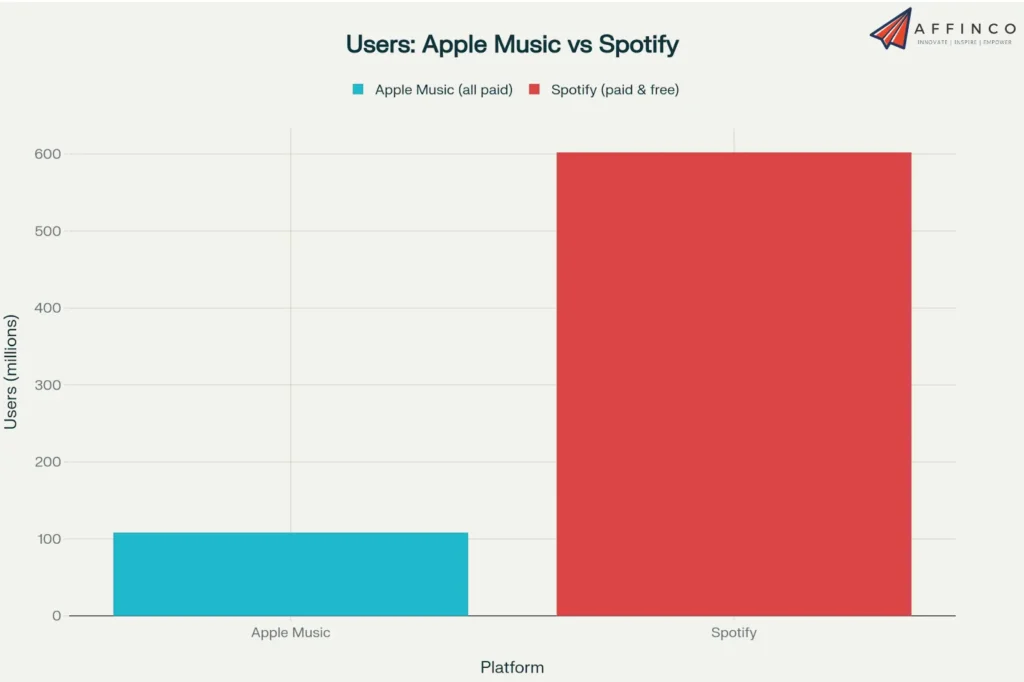
A direct comparison of their key metrics reveals their different strategies and strengths.
| Metric | Apple Music | Spotify |
|---|---|---|
| Total Users | 108 million (all paid) | 602 million (paid & free) |
| Revenue (2023) | $9.2 billion | €13.24 billion |
| Pay per Stream | $0.01 | $0.003-$0.005 |
| Audio Quality | Lossless/Spatial Audio | Standard/Premium |
This comparison shows two different paths to success. Spotify focuses on massive scale through a freemium model, while Apple Music targets the premium segment of the market for higher per-user revenue.
Competitor Comparison: Amazon Music & YouTube Music
Beyond Spotify, Apple Music also competes with other major players like Amazon Music and YouTube Music. These services also hold significant shares of the music streaming market.
Apple Music distinguishes itself from these competitors through its focus on high-fidelity audio and deep integration with its own hardware. This strategy helps it maintain a loyal user base despite the crowded market.
Future Growth Projections
Analysts expect Apple Music to continue its growth trajectory in the coming years. Forecasts predict a steady increase in subscribers as the platform expands into new markets and enhances its features.
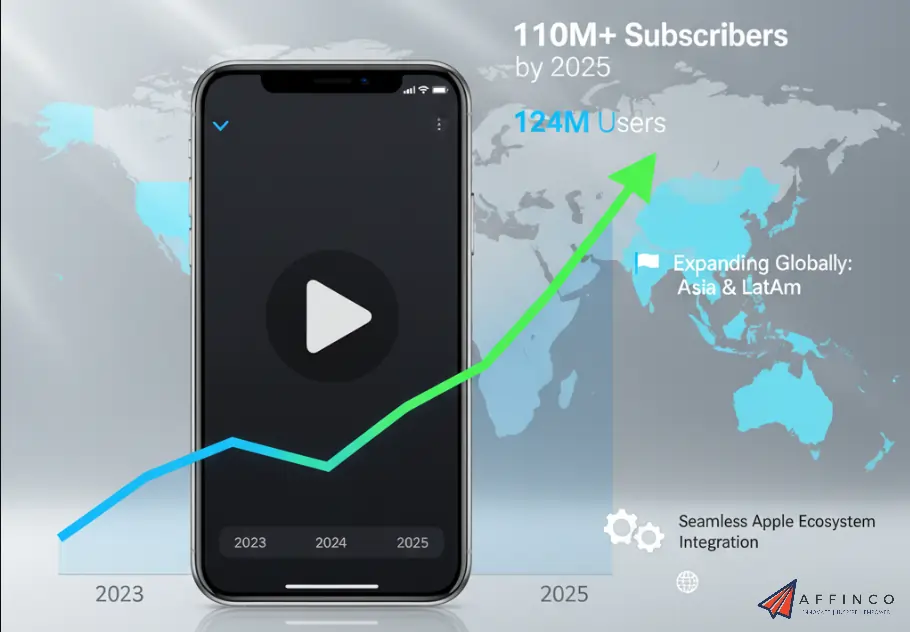
These projections suggest that Apple Music will remain a top player in the industry.
The outlook for Apple Music is positive, with plenty of room for further expansion. The platform's strong brand and high-quality offering position it well for the future.
Strategic Importance for Apple
Apple Music is more than just a standalone product; it is a critical piece of the Apple ecosystem. It helps to lock users into Apple's hardware and software, increasing customer loyalty and retention.
The service creates a powerful synergy with products like the iPhone, HomePod, and Apple Watch.
- By offering a premier music service, Apple provides a compelling reason for customers to stay within its ecosystem.
- The seamless integration across devices makes it an easy and convenient choice for anyone who owns Apple products.
- Features like Siri voice commands and iCloud Music Library synchronization add to this convenience.
- The platform also serves as a gateway to other Apple services, such as Apple One bundles.

This integration makes the service “stickier” than third-party alternatives. It is a key part of Apple's strategy to build a comprehensive and interconnected digital life for its customers.
Final Insights on Apple Music Growth
Apple Music's expansion across 167 countries and 20% global market share proves subscription-focused strategies work. With 56% female users and Taylor Swift leading at 70.2 million total streams, Apple has built a loyal community that values quality over quantity.
Music streaming wars aren't slowing down, and Apple's premium-only approach continues paying off through consistent growth and artist-friendly rates.
While competitors chase user numbers through free tiers, Apple focuses on revenue per subscriber and ecosystem integration.
What streaming strategy will dominate as competition intensifies in 2026?


Ali
Ali is a digital marketing expert with 7+ years of experience in SEO-optimized blogging. Skilled in reviewing SaaS tools, social media marketing, and email campaigns, we craft content that ranks well and engages audiences. Known for providing genuine information, Ali is a reliable source for businesses seeking to boost their online presence effectively.






